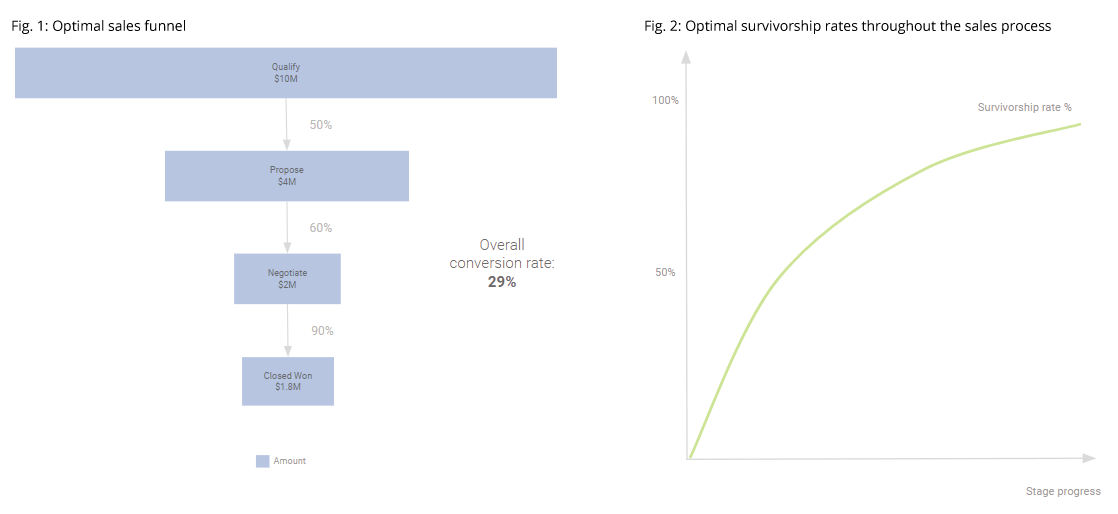In our last blog post, we previously discussed the idea of the sales machine that converts input into output, and it is this conversion process (the conversion rate) that makes the real difference between a decent sales manager and a great sales manager. Honing this process to perfection is what allows you to have a successful system in place with a repeatable set of activities that lead to predictable, and favorable outcomes.
You may say to yourself, “Now, that’s sounds great in theory but sales will never be a perfect science.” That is true indeed–at least for the vast majority of selling processes out there. But you don’t need to worry, 100% systematic perfection is not what’s needed most of the time. There are plenty of low hanging fruits out there that help you measure and improve your conversion rate, and we will discuss some of them here.
Optimize the Shape of Your Sales Funnel
In its simplest definition, the conversion rate is defined as the percentage of visitors or points of contact who take a desired action. The desired action is defined in a company’s sales or marketing processes. Conversion rate can be measured from macro and micro perspectives in the sales funnel. For example, a macro perspective may define conversion rate by all customers who make it from the beginning of the funnel to the end, e.g. who moves from Qualify to Closed-Won. A micro perspective would examine the individual conversion rate between stages, e.g. how many moved from Qualify, the first stage, to Propose, the second stage.
The sales funnel is a representation of how opportunities move through the sales stages, sometimes called “survivorship.” The notion “funnel” stems from the common perception that you start with a lot of input which is constantly narrowed down from stage to stage until only a fraction survives, your Closed-Won deals.
The problem with that is the pipeline shouldn’t narrow down equally throughout the whole process! The weeding out should primarily happen in the early stages of the sales process during Qualification, and it is perfectly normal (even desirable) to have a low survivorship rate there. Separating the cream of the crop early on is what allows you to maintain a high-quality pipeline down the road.
Equally, the further down the road a deal has progressed in terms of stage, the smaller the dropout-rate and thus the higher the survivorship rate needs to become. If you still lose 50% of the deals that progressed into final Negotiation stage, it just means they haven’t been properly vetted and assessed early on and were merely dragged along–having wasted both you rep’s and prospect’s time.
The optimal shape of the sales funnel is thus marked by a sharp narrow down in the early stage(s), and very little narrowing in the late stage(s). In other words, the survivorship from stage-to-stage needs to go up!

Establish a Formal Process to Recycle Dropouts
Recycling is not just a topic applicable to waste management, it plays also an important role in pipeline management! All too often we see that once a deal is marked as Closed-Lost the prospect account is forgotten and off the sales radar because it is no longer in the funnel. That would be waste because you’ve already spent resources to engage, even pitch to the prospect, but a Closed-Lost opportunity does not have to mean the prospect is lost for good. Instead, feed that account back into either an earlier stage of the sales process, or to your pre-sales, marketing team to continue nurturing the relationship.
But the big differentiator is how smart you go about this. Let’s say you had already identified the buyer and have established interest in your product, but due to timing and/or budget constraints it came to no purchase. You have already gained knowledge on the prospect’s situation and pain points and need to tailor your approach to this. Your product didn’t exactly meet their needs? Inform that there is a new version that now addresses it. Was pricing the issue? Tell them when there is a discount for this product.
The key is to formalize this process:
- Define an enumerated set of dropout reasons (also for Wins!) in your CRM and enforce it to be populated by the rep whenever an opportunity is closed: e.g. Pricing, Missing Feature, Timing, Not Fit for Client, and so on. It is also good practice to additionally add a free text field in your CRM for a more detailed description.
- Add tailored follow-up workflows for each dropout type, such as:
- Move dropouts from the early Qualification stage with reason: “No Fit” to the list of general unqualified leads and have marketers handle it
- Folks that that dropped off because of Pricing, put them on the “Send promotions” list
- Analyze the dropout reasons by stage: we discussed above that dropouts should become less frequent the further down the sales process you get. More importantly, certain dropout reasons should not occur at later stages. For example, you made a proposal and ran through a trial with your prospect, so at this stage pricing shouldn’t be something that kills the deal, this would have been discussed in the Qualification phase.
Ingo is a Solution Architect at Vortini. He has been designing and implementing sales analytics solutions for more than ten years.


hipcraft
Jess Gonzalez